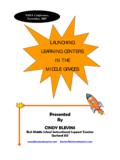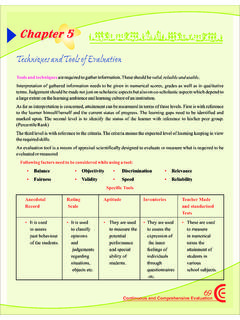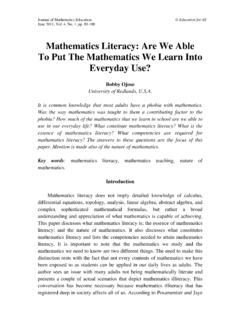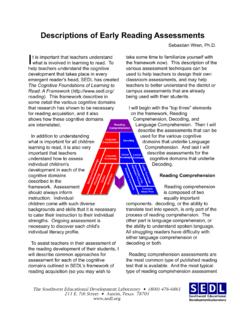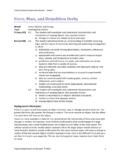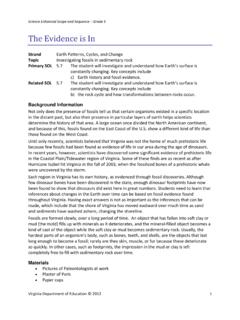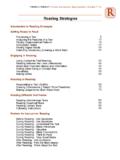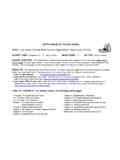Transcription of Reading Response for Fiction - Teacher Direct
1 Gr a d e s 2 4 Reading Responsefor FictionGraphic Organizers & Mini-LessonsJe n n i f e r Ja c o b s o nReading Response for Fiction Graphic Organizers & Mini-Lessons 2008 by Jennifer Jacobson, Scholastic Teaching ResourcesAcknowledgmentsMany thanks to Jim Becker, Danielle Blood, Kathleen Hollenbeck, and Mackie RhodesTeachers who wish to contact Jennifer about her staff development programs may visit her Web site at grants teachers permission to photocopy the reproducible pages in this book for classroom use. No other part of the publication may be reproduced in whole or part, or stored in a retrieval system, or transmitted in any form or by any means, electronic, mechanical, photocopying, recording, or otherwise, without written permission from the publisher.
2 For information regarding permission, write to Scholastic Inc., 557 Broadway, New York, NY by Kathleen HollenbeckCover design by Maria LiljaInterior design by Holly GrundonInterior illustrations by Teresa AnderkoISBN-13: 978-0-439-57294-1 ISBN-10: 0-439-57294-0 Copyright 2008 by Jennifer JacobsonPublished by Scholastic rights in the 2 3 4 5 6 7 8 9 10 40 15 14 13 12 11 10 09 08 Reading Response for Fiction Graphic Organizers & Mini-Lessons 2008 by Jennifer Jacobson, Scholastic Teaching ResourcesContentsIntroduction ..4 Connections to the Standards ..6 References and Additional Resources ..7 Mini-LessonsThat Reminds Me! (making personal connections) ..8 Comparing Stories (comparing story attributes) ..10 Setting Clues (visualizing settings).
3 12 What a Character Wants (examining character motives and actions) ..14 Characters That Change (making inferences) ..16 Show or Tell? (analyzing character emotions) ..18 Tell It Again! (identifying plot structure) ..20 Cause-and-Effect Machine (recognizing cause-and-effect relationships) ..22 Ringing in the Plot (identifying main plot and subplot) ..24 Questions and Clues (asking questions) ..26 Memorable Images (visualizing) ..28 Worthy Words (examining author s word choice) ..30 Genre Comparison Castle (comparing and contrasting within a genre) ..32 Another Time and Place (classifying) ..34 Book Review Interview (summarizing) ..36 Agree or Disagree? (exploring opinions) ..38 You re in the Story! (making connections) ..40 Did You Hear? (making inferences).
4 42 Driving Home the Theme (identifying theme) ..44 Happy Endings (analyzing story endings) ..46 Reading Response for Fiction Graphic Organizers & Mini-Lessons 2008 by Jennifer Jacobson, Scholastic Teaching ResourcesIntroductionWelcome to Reading Response for Fiction : Graphic Organizers & Mini-Lessons! Designed for flexible use, these 20 graphic organizers promote Reading Response , guiding students to think about and analyze what they read and leading them to read with deeper engagement. By completing the organizers in this book, students receive practice in constructing, examining, and extending meaning; reflecting on the content of text; and refining their Reading strategies. Why Use Graphic Organizers for Reading Response ?Graphic organizers provide schemata: a way of structuring information or arranging key concepts into a pattern, enhancing comprehension and imparting useful learning strategies (Bromley et al.)
5 , 1995). Organizers offer students an efficient way to Direct their attention, record key information, display their thinking, and monitor their use of learning strategies. Research has shown that graphic organizers help students to: connect prior knowledge to new information (Guastello, 2000). integrate language and thinking in an organized format (Bromley et al, 1995). increase comprehension and retention of text (Boyle & Weishaar, 1997; Chang et al., 2002; Moore & Readence, 1984). engage in mid- to high-level thinking along Bloom s Taxonomy (knowledge, comprehension, synthesis, and evaluation) (Dodge, 2005).The Reading Response graphic organizers in this book focus on comprehension, Reading strategies, story elements, and author s craft.
6 All of the organizers allow students to build upon their prior knowledge, use critical thinking skills, and express what they ve learned in their own words. How to Use This BookThe organizers in this book can be used in any order and lend themselves well to many forms of teaching: pre- and post-assessment, preparation for literature circles, and mini-lessons. They are suitable for use with the whole class, small groups, or individual students, and are ideal for homework or guided cooperative learning organizer targets a different skill or combination of skills, which is shown on each lesson page. At the top of the page, a purpose states the uses and benefits of the activity, and the suggestion for introducing the lesson helps set the stage and pique student interest.
7 Step-by-step directions provide a guide for demonstrating how to use and complete the organizer. Also included is a helpful management tip, which recommends one or more specific ways to use the graphic organizer, and an activity that lets you take students a step further by building on the skills and strategies covered in the lesson or by using the organizer for a different purpose. Finally, to help you get started, books and resources that are referred to in the sample lesson or that might be appropriate for that particular lesson are listed in the literature link on the page. The unread story is not a story; it is little black marks on wood pulp. The reader, Reading it, makes it live: a live thing, a story. Ursula LeGuinReading Response for Fiction Graphic Organizers & Mini-Lessons 2008 by Jennifer Jacobson, Scholastic Teaching ResourcesUsing a Graphic OrganizerSelect the graphic organizer that best suits your instructional needs.
8 Then follow these suggestions to prepare and use the organizer with students. Test It. Before using an organizer, give it a trial run on your own to experience the process firsthand. This will allow you to see how well the graphic works with the selected text. Make any modifications necessary to best meet the needs of your students (Egan, 1999). Present It. Determine the best method for presenting the graphic organizer. You might make a photocopy for use as a transparency on the overhead projector, or distribute paper copies to students to complete as you model its use. Keep a supply of frequently used organizers on hand for students to use independently. Model It. Research has shown that graphic organizers are most effective when the Teacher presents and models the organizer first for the whole group (Bowman et al.)
9 , 1998). To ensure greatest success, model the use of each organizer with the whole class before asking students to complete it independently. Helpful Hints for Success You might choose a picture book or familiar fairy tale as your literature selection when introducing a Reading Response graphic organizer for the first time. With these, you can present an entire story in one lesson, allowing students to focus on the goal and structure of the organizer. Introduce the organizer before students read. That way, students will read with a strong sense of purpose and focus. Model the use of the organizer so that students will gain a clear understanding of its purpose and how to complete it. When analyzing text during a mini-lesson, think out loud.
10 This will allow students to recognize and apply your strategies for greater Reading comprehension. Provide adhesive note strips for students to mark passages that they will later refer to when completing their organizers. Urge students not to feel limited by the design of a graphic organizer. Demonstrate writing outside the lines and adding other shapes and lines when making new connections. Provide a rich selection of Reading materials and a variety of Reading Response graphic organizers to use with them. This will help keep your Reading program fresh and interesting. As teachers model their own Response to literature (through thinking aloud and use of graphic organizers), they make Reading strategies explicit. Regular modeling, opportunities to practice and apply the strategies, and consistency in contexts allow students to transfer this knowledge to independent Reading and assessment situations (Pardo, 2004).

